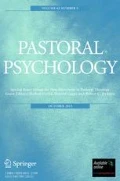Abstract
Burnout and depression among Roman Catholic secular, religious order, and monastic (Cistercian) priests was investigated using the Maslach Burnout Inventory (MBI) and the Center for Epidemiological Studies-Depression (CESD) scale. Additionally, a Self-Report-Inventory (SRI) was included requesting information on demographics as well as four categories of predictor variables (vocational satisfaction, social support, spiritual activities, and physical environment) associated with burnout and depression. All participants were randomly selected. The survey yielded a return rate of 90.67%. Secular clergy reported significantly greater emotional exhaustion than did monastic clergy. Secular priests also had significantly greater depression (72%), when compared to religious (40.8%) and monastic (39.5) clergy. Overall group comparisons revealed that secular clergy experienced the highest degree of burnout and depression, monastics the least, and religious priests falling in between. The lack of social support and sense of isolation, for secular clergy, were key elements associated with their experience of both burnout and depression.
Similar content being viewed by others
REFERENCES
Boyd, J. H., Weissman, M. M., Thompson, W. D., & Myers, J. K. (1982). Screening for depression in a community sample: Understanding the discrepancies between depression syndrome and diagnostic scales. Archives of General Psychiatry, 30, 1195-1200.
Byrne, B. M. (1991). The Maslach Burnout Inventory: Validating factorial structures and invariance across intermediate, secondary, and university educators. Multivariate Behavioral Research, 26, 583-605.
Devins, G. M., Orme, C. M., & Costello, C. G. (1988). Measuring depressive symptoms in illness populations: Psychometric properties of the Center for Epidemiologic Studies Depression (CES-D) scale. Psychology and Health, 2, 139-156.
Farber, B. A. (1983). Stress and burnout in the human service profession. New York: Pergamon Press.
Fry, T. (Ed.). (1982). The Rule of St. Benedict in English. (J. Neufville, Trans.). Collegeville: Minnesota, St. John's Press.
Glass, D. C., McKnight, J. D., & Valdimarsdottir, H. (1993). Depression, burnout, and perceptions of control in hospital nurses. Journal of Consulting and Clinical Psychology, 61, 147-155.
Kenedy, J. P., & Sons (Eds.). (1996). The official Catholic directory. New Providence, N.J.: Reed Publishing Company, Inc.
Kenedy, J. P., & Sons (Eds.). (1997). The official Catholic directory. New Providence, N.J.: Reed Publishing Company, Inc.
Maslach, C. (1982). Understanding burnout: Definitional issues in analyzing a complex phenomenon. In W. S. Paine (Ed). Job Stress and Burnout (pp. 29-40). Beverly Hills, CA: Sage Publication.
Maslach, C., & Jackson, S. E. (1981). The measurement of experienced burnout. Journal of Occupational Behavior, 2, 99-113.
Maslach, C., & Jackson, S. E. (1996). The Maslach Burnout Inventory Manual. Palo Alto, CA: Consulting Psychologist Press (1982).
Myers, J. K., & Weissman, M. M. (1980). Use of a self-report symptom scale to detect depression in a community sample. American Journal of Psychiatry, 137, 1081-1084.
Pines, A. M., Aronson, E., & Kafry, D. (1981). Burnout: From tedium to personal growth. New York: The Free Press.
Radloff, L. S. (1977). The CES-D scale: A self-report depression scale for research in the general population. Applied Psychological Measurement, 1, 385-401.
Radloff, L. S., & Teri, L. (1986). Use of the Center for Epidemiological Studies-Depression Scales with older adults. Clinical Gerontologist, 5, 119-136.
Roberts, R. E., & Vernon, S. W. (1983). The Center for Epidemiological Studies Depression Scale: Its use in a community sample. American Journal of Psychiatry, 140, 41-46.
Virginia, S. G. (1994). Burnout among Roman Catholic secular and monastic clergy. Unpublished masters thesis, Xavier University, Cincinnati, Ohio.
Author information
Authors and Affiliations
Additional information
Candidate in Psychology at
and a Psychology Intern at the Ohio State University
Rights and permissions
About this article
Cite this article
Virginia, S.G. Burnout and Depression Among Roman Catholic Secular, Religious, and Monastic Clergy. Pastoral Psychology 47, 49–67 (1998). https://doi.org/10.1023/A:1022944830045
Issue Date:
DOI: https://doi.org/10.1023/A:1022944830045



